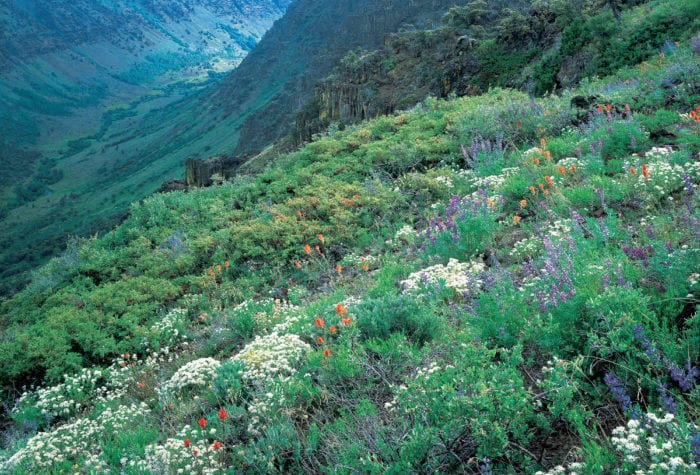The early life cycles of both fish are initially similar, beginning with eggs laid,fertilized and matured in a nest structure—the “redd”—excavated in the river gravels and cobbles by the female.
Two key factors are crucial to young fish development:
- cold, clear, well-oxygenated water. A stable cold temperature reduces the heat stress that can come with low water flows.
- low “scour rate.” Scour refers to a specific form of erosion, and the key is to protect the redds from large flood events.
Both of these requirements for successful spawning come as a result of a reasonably stable landscape, which is characterized by:
• relatively steady flows, like the spring and aquifer fed Deschutes
• well-vegetated stream banks to shade and cool the water, common in the upper reaches of the John Day
• plant material to provide food for aquatic invertebrates on which they feed, common in the Deschutes and the John Day
• natural meanders, big rocks, and plenty of large woody debris to slow the flow and offer protection to young fish, especially common in rivers without dams to impede debris flow, such as the John Day
From alevin to smolt
The young fish have several names at different stages, depending upon their level of maturity.
First, they are an alevin, a tiny fish with the yolk sack still attached, who mature into fry, and later into smolts. The smolts of both trout and steelhead grow well initially in freshwater, where they eat insects and other aquatic foods, but must also avoid predation. Steelhead young grow fast, yet can remain stream bound for up to three years. At this stage, it can be close to impossible to tell them from young trout.
Head to the sea, or stay in the stream
At some point, steelhead smolts feel the call of the ocean, and this is where their life stories dramatically diverge.
As they migrate downstream, steelhead must pass several dams in the Columbia River to get into the ocean. Once there, the abundant marine food supply enables them to quickly grow quite large. Adult steelhead spend up to seven years in the ocean, and upon reaching spawning age will migrate back upstream, once again pass over the several dams that stand in their way.
Meanwhile, their stream-bound rainbow cousins are limited in the diversity of their habitat, especially regarding abundance of their food supply, and they just cannot grow as fast or as big. Life in a smaller stream also means that they are more likely to suffer to predation, and more vulnerable to heat increases, flooding or low water stresses, plus all of the other threats inherent in their more proscribed habitat.
You might wonder why all O. mykiss babies don’t just opt for the anadramous (ocean-going) lifestyle and migrate. Genetics comes into play: a fish spawned from an anadramous mother will most likely become an anadramous adult. And, habitat plays a role: the larger the stream the fish are spawned in points to them becoming larger, likely anadramous, steelhead. This is because larger streams and tributaries tend to be more resilient, offer a more diverse habitat, provide more food and better protection, thus creating larger, more likely to be anadramous, fish. Conversely, smaller tributaries give rise to smaller fish, offering a home to the rainbows who stay put.
If you want to have more steelhead, the short answer is to protect and enhance the quality of their habitat and ensure that they can spawn in larger streams.

